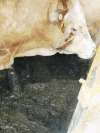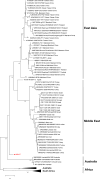Coinfection of Bovine ephemeral fever virus and 'Candidatus Mycoplasma haemobos' in cattle in Central China: implications for tick-borne transmission and viral divergence
- PMID: 40646593
- PMCID: PMC12255009
- DOI: 10.1186/s12917-025-04917-3
Coinfection of Bovine ephemeral fever virus and 'Candidatus Mycoplasma haemobos' in cattle in Central China: implications for tick-borne transmission and viral divergence
Abstract
Background: In central China, free-range cattle face high risks of exposure to arthropod-borne pathogens like Bovine ephemeral fever virus (BEFV) and 'Candidatus Mycoplasma haemobos' ('Ca. M. haemobos'). Despite their co-endemicity, the role of ticks in BEFV transmission remains unexplored in China, and potential interactions between these pathogens are unknown. This study aimed to (1) investigate the coinfection of BEFV and 'Ca. M. haemobos' in cattle fever outbreaks, (2) evaluate ticks as potential vectors for both pathogens, and (3) characterize viral evolution.
Results: From August to September 2024, blood, tissue, and tick samples were collected from 61 clinically ill cattle (Group 1) and 17 asymptomatic cattle (Group 2) in the same farms, and 18 healthy cattle (Group 3) in six different farms in central China. Ticks were morphologically and molecularly identified. Pathogens were screened by PCR and sequencing analysis. The serum was subjected to virus neutralization assays. In Group 1, BEFV and 'Ca. M. haemobos' were detected in 86.9% and 67.2% of cattle, respectively, with a coinfection rate of 44.3% (27/61). All deceased cattle (8/8) tested positive for BEFV, and 75% were coinfected. Ticks (Haemaphysalis longicornis, Rhipicephalus microplus, Rhipicephalus sanguineus sensu lato) from Group 1 carried BEFV (46.8%, 11.3%, and 18.8%) and 'Ca. M. haemobos' (34.8%, 35.5%, and 31.3%). Engorged H. longicornis exhibited higher BEFV infection rates than unfed ticks (p < 0.001). In Group 2, the two pathogens were only detected in H. longicornis ticks with positive rates significantly lower than those in ticks in Group 1 (p < 0.05). In Group 3, all samples were negative for the pathogens. Moreover, the BEFV strain HN2437 in this study showed divergence from global lineages, suggesting unique evolution. Neutralizing antibodies against BEFV were only found in cattle in Group 1 with the seroprevalence rate of 26.2% (16/61).
Conclusions: This study provides the first evidence of ticks as potential BEFV carriers in China and highlights that coinfection with 'Ca. M. haemobos' may be a factor in severe disease outcomes. The distinct evolutionary profile of HN2437 strain underscores the need for evaluating effect of vaccine in use.
Keywords: Haemaphysalis longicornis; Rhipicephalus microplus; Rhipicephalus sanguineus sensu lato; Bovine ephemeral fever virus; Cattle; ‘Candidatus Mycoplasma haemobos’.
© 2025. The Author(s).
Conflict of interest statement
Declarations. Ethics approval and consent to participate: Informed consent of the goat owner is provided in the study. The study was carried out in compliance with the ARRIVE guidelines. All methods were carried out in accordance with Chinese Law for the Care and Use of Animals. The research protocol was approved by the Animal Welfare and Ethics Committee of Nanyang Normal University (approval no. No 24033, year: 2024). Consent for publication: Not Applicable. Competing interests: The authors declare no competing interests.
Figures


Similar articles
-
Abortion outbreak in pregnant goats and cows with coinfection of 'Candidatus Mycoplasma haemobos' and HoBi-like pestivirus.Vet Microbiol. 2023 Apr;279:109690. doi: 10.1016/j.vetmic.2023.109690. Epub 2023 Feb 10. Vet Microbiol. 2023. PMID: 36791616
-
Molecular detection of haemophilic pathogens reveals evidence of Candidatus Mycoplasma haemobos in dogs and parasitic ticks in central China.BMC Vet Res. 2022 Jul 1;18(1):254. doi: 10.1186/s12917-022-03361-x. BMC Vet Res. 2022. PMID: 35778709 Free PMC article.
-
Molecular investigation reveals three hemotropic mycoplasmas in cats and three tick species in China.Front Vet Sci. 2025 Jan 30;12:1522904. doi: 10.3389/fvets.2025.1522904. eCollection 2025. Front Vet Sci. 2025. PMID: 39950087 Free PMC article.
-
Tick-Borne Diseases in Sub-Saharan Africa: A Systematic Review of Pathogens, Research Focus, and Implications for Public Health.Pathogens. 2024 Aug 17;13(8):697. doi: 10.3390/pathogens13080697. Pathogens. 2024. PMID: 39204297 Free PMC article.
-
Distribution of Rhipicephalus sanguineus and Heamaphysalis elliptica dog ticks and pathogens they are carrying: A systematic review.Vet Parasitol Reg Stud Reports. 2024 Jan;47:100969. doi: 10.1016/j.vprsr.2023.100969. Epub 2023 Dec 12. Vet Parasitol Reg Stud Reports. 2024. PMID: 38199685
References
-
- National Bureau of Statistics of China. Number of livestock 2022, [https://data.stats.gov.cn/easyquery.htm?cn=E0103]
-
- Li Z, Zheng F, Gao S, Wang S, Wang J, Liu Z, Du J, Yin H. Large-scale serological survey of bovine ephemeral fever in China. Vet Microbiol. 2015;176:155–60. - PubMed
-
- Shi H, Kan Y, Yao L, Leng C, Tang Q, Ji J, Sun S. Identification of natural infections in sheep/goats with hobi-like pestiviruses in China. Transbound Emerg Dis. 2016;63:480–4. - PubMed
-
- Shi H, Hui R, Zhou M, Wang L, Li G, Bai Y, Yao L. Abortion outbreak in pregnant goats and cows with coinfection of ‘candidatus mycoplasma haemobos’ and hobi-like pestivirus. Vet Microbiol. 2023;279:109690. - PubMed
MeSH terms
Grants and funding
LinkOut - more resources
Full Text Sources
Medical

